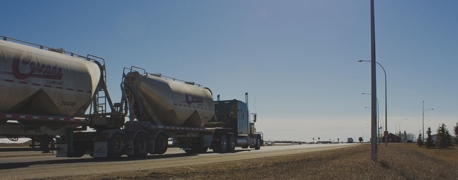Driving Jobs Not Affected by Standard Hours of Service

Hours of Service (HOS) regulations are in place to ensure that truckers are not driving while tired and endangering themselves or others. These regulations have shaped the work day for hundreds of thousands of commercial drivers, dictating when they can drive and when they must rest. However, not every commercial driver is governed by the same Hours of Service rules. Making some jobs, like delivery of farm products and oilfield parts, exempt from normal HOS rules helps keep certain types of businesses running.
Exemptions from standard HOS rules sometimes come with industry-specific or state-specific rules governing how long truckers can operate. These rules are adapted to the unique challenges faced in these contexts. For example, the challenges of making deliveries in Alaska have led to rules that only apply within Alaskan borders (like we write about below).
In today's article, we will explore some of the driving professions that don't have to follow HOS regulations—and what regulations they have to follow instead.
Transporting Construction Materials
Commercial motor vehicle (CMV) drivers who drive in construction have a shorter restart period than normal CMV drivers, as long as they're transporting materials within a 75-air-mile radius. While other CMV drivers require a 34-hour restart to reset their on-duty 'counter' to 0 hours, drivers who transport construction materials and equipment need only 24 hours of off-duty time to restart every 7 or 8 days.
The 24-hour restart provision does not apply to drivers who transport placard-required hazardous materials.
Driving in the Oilfields
The oil and gas industry needs truckers to deliver equipment, piping, and supplies for servicing well operations. To facilitate more efficient oil-and-gas operations, federal regulations around oilfield truckers are slightly different. For one thing, oilfield truckers have a 24-hour restart period after 7 or 8 consecutive days of work instead of a 34-hour period. Operators of pickup-style pipeline welding trucks are exempt from HOS rules as well.
Even more significant, truckers who exclusively handle oil well-servicing vehicles can log waiting periods at wells as "off-duty" and 'pause' their 14-hour on-duty clock. If the waiting time is longer than 2 hours, truckers can actually create the equivalent of a 10-hour off-duty period by logging the time as rest or sleeper berth time (similar to the split-sleeper rule).
Driving for the Agricultural Industry
During the state-determined planting and harvesting season, truckers transporting agricultural goods or supplies are exempt from hours of service regulations. In addition, drivers who operate farm vehicles are exempt from HOS rules.
Utility Service Vehicles
Are you driving to service electric, gas, water, sanitary, sewer, or television utilities? Then you don't have to abide by HOS regulations. Linemen, sanitation drivers, and other jobs all fall under this exemption. A related exemption allows truckers transporting groundwater drilling rigs to use a shorter 24-hour reset instead of the standard 34-hour reset after 7/8 consecutive days of work.
Christmas Delivery Within 100 Air-Miles
Yes, the federal service regulations officially give a free pass to Santa Claus—as well as any drivers who are a) exclusively making local deliveries from retail businesses b) direct to consumers in c) the two weeks before Christmas (as long as the consumer is within 100 air-miles of the driver's "work reporting location").
Alaskan Drivers
Drivers operating in Alaska have to abide by Hours of Service regulations that are slightly different from the U.S. standard HOS rules. Specifically, they have different rules that replace the normal 11-hour driving rule and 14-hour on-duty rule. In Alaska, drivers have the 15-hour rule and the 20-hour rule. Essentially, that means that a driver operating a CMV after 10 consecutive hours off-duty can only drive for a total of 15 hours before needing another 10-hour rest period. Additionally, they cannot drive after the 20th hour of being on-duty following a 10-hour rest period.
There are a few reasons for these extended rules, but suffice it to say that Alaska is an enormous state that relies on shipping for crucial supplies. As a result, truckers are allowed to drive for longer periods to cover larger distances.
Exemptions for Truckers in the Rail Industry
Railroad work often requires long distances between duty assignments. Hi-rail vehicles (classified as a kind of CMV) have to travel between different maintenance assignments all over a single track. Hi-rail vehicles and railroad signal employees both enjoy exemptions from standard HOS rules. Hi-rail vehicle drivers don't include their travel time to/from duty assignments as long as it's less than 2 hours (and doesn't exceed 30 hours in a single month). Railroad signal employees, or workers handling signal systems on behalf of an FRR-regulated railroad carrier, are completely exempt from HOS rules.
Truckers in the Movie Industry
Trucking factors into a lot of movie production. Transporting sets, talent, equipment, and supplies are all a part of running an efficient production site. Federal regulators understand that traveling at odd hours or for lengthy periods is key to making movies, which is why movie production CMV operators have different rules. As long as a CMV operator is transporting people and property within a 100-air-mile radius of a production site, they're exempt.
Movie production drivers enjoy exemptions from the following rules:
- The 11-hour driving rule
- The 14-hour on-duty rule
- The 30-minute break requirement after 8 hours
However, movie production drivers do need to spend 8 consecutive hours off-duty after no more than 10 hours of driving within a 15-hour on-duty window. Keep in mind as well that transporting production property to a shooting location long-distance doesn't apply here; that's why there's a 100-mile radius stipulation.
The Importance of Adapting Trucking Laws to Different Contexts
Ground transportation is sometimes the only way for goods/services to be transported to their ultimate destination. But how transportation happens in different places or contexts requires unique rules. With the exemptions we've listed above, truckers are able to become a vital part of any industry, regardless of the demands it puts on them.
And for truckers, both present and future, that's a good thing.


